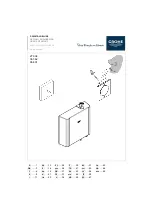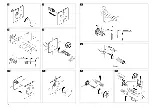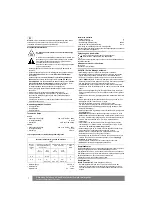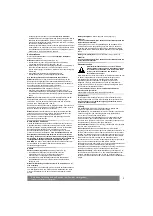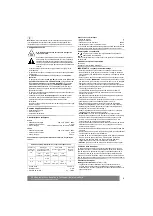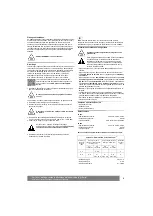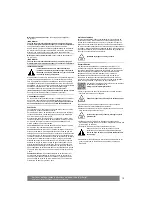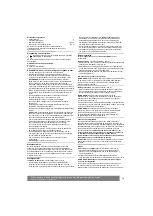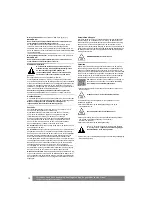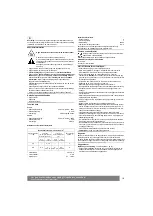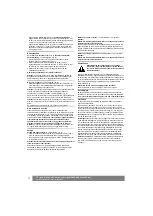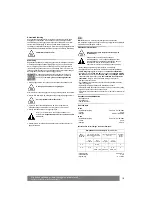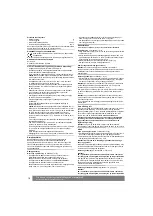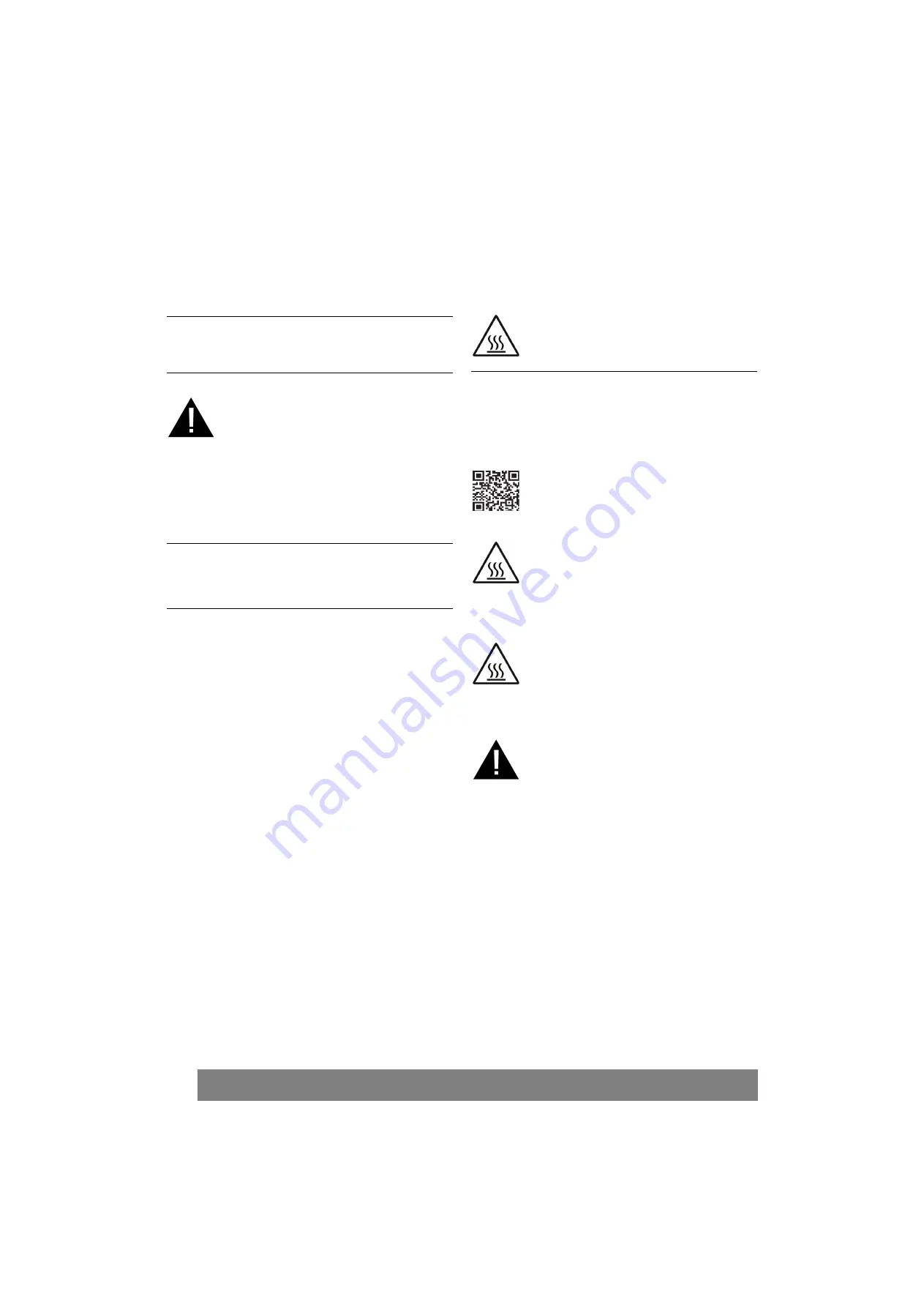
5
Steam nozzle installation
,
see fold-out page II, Fig. [6] to [11].
IMPORTANT NOTE!
Read the technical product information provided with the concealed
mounting sets for the steam nozzle and feeler gauge.
The steam nozzle must be installed in the steambath cubicle at a height
of 50 to 400mm and routed underneath the seats in the room in
a longitudinal direction. Do not direct the steam jet against walls, seats or
other objects. Keep a minimum of 700mm away from the steam nozzle.
Feeler gauge installation
,
see feeler gauge II, Fig. [12] to [15].
IMPORTANT NOTE!
Read the technical product information provided with the concealed
mounting sets for the steam nozzle and feeler gauge.
Electrical installation
Electrical installation work must only be performed
by a qualified electrician. This work must be carried
out in accordance with the regulations according to
IEC 60364-7-701 (corresponding to VDE 0100 Part 701)
as well as all national and local regulations.
The device must be connected to the mains power supply via an FI switch
(maximum release current 30 mA). The power supply for the steam
generator must be established via a socket connected directly to the
mains fuse box, see fold-out page I, Fig. [5]. Unobstructed access to
the socket must be guaranteed after installation. No switches should
be connected to this cable. See also section "Automatic drainage".
Check that the electrical socket used is earthed!
Switch on the main switch and check whether smoke emerges.
Main switch
There is an on/off switch at the base of the steam generator that should
only be actuated if the device has not been used for a long time.
The
device is not drained automatically when disconnected from the
power supply!
Ventilation
Steambath cubicles do not generally require special ventilation if operated
for less than two hours.
In steambath rooms that operate continuously for more than two hours,
the air must be changed at a rate of 10-20m³ per person per hour for
hygiene and functional reasons.
Any clear space above the steambath cubicle must not be closed off.
Drill or cut a ventilation opening (1000mm²) into the wall where the door
is located to ventilate the cavity above the steambath cubicle.
The air inlet
consists of an opening in the door wall near to the floor or
a gap under the door.
The air outlet
must be integrated at the very top of the wall or in the
ceiling and should be positioned as far away from the air inlet as possible.
However, it should not be positioned above the door or directly above one
of the seats. The outlet is connected to an air duct that leads outside.
An existing air duct can be used. The duct must be completely steam and
watertight and designed to withstand the high degree of moisture in the
air. Bends that allow the formation of "pockets of condensate" which affect
the function of the duct are not permitted. If pockets of water are
unavoidable, a water separator must be installed to drain the condensate.
The air outlet must be large enough to discharge 10–20m³ of air per
person per hour.
Mechanical ventilation.
If the air does not escape quickly enough by
itself, e.g. through negative pressure in the room where the steambath
cubicle is located, a ventilator must be installed. The fan must be set to
extract a minimum of 10m³ and a maximum of 20m³ of air per person per
hour.
Automatic drainage
This automatic control considerably reduces the accumulation of calcium
carbonate and other deposits in the water tank. If there is a switch in the
cable between the power supply and the steam generator, it can only be
actuated 110 minutes after the system is switched off so that the water
tank can drain and flush automatically. It is therefore important that a faulty
electrical connection does not render inoperative the automatic drainage
function on the steam generator.
WARNING! The water is hot!
Descaling
Regular descaling is important because it extends the service life of the
steam generator and ensures that it functions correctly. Descaling
removes limescale deposits from walls and heating elements. The user
has the option of descaling automatically after 130 hours of operation
(preset interval) or descaling manually before the 130 hours elapse.
The descaling time is displayed on the control panel of the terminal
device. The steam generator is disabled when the time elapses.
Additional instructions on how to use the app
and activate the functions can be downloaded at
www.grohe.com/tpi/f-digital-deluxe
.
1.Start the steam generator and allow to operate until the water in the
container starts to boil.
Hot steam may escape from the steam outlet.
The steam generator stops after 20 minutes. The heating phase for
descaling is complete.
2.Unscrew the cap nut from the three-way coupling at the top of the steam
generator.
Caution hot! Protect against burns!
3.Pour two 80g packs of descaling agent into the container via the three-
way coupling using a funnel (Prod no.: 14 015 000).
4.Screw the cap nut back onto the three-way coupling.
After approx. 1,5 hours, the container is drained and flushed
clean automatically.
The steambath cubicle must not be
used during this time period.
5.Reset the timer for the descaling interval as described in the Grohe SPA
app operating instructions.
Please pass these instructions on to the fitting user!
The right to make technical modifications is reserved!
Summary of Contents for F-digital deluxe 27 934
Page 3: ...III IV II 6 7 10 11 9 12mm 8 12 24mm 13 14 1 15...
Page 32: ...29...
Page 33: ...30...
Page 74: ...Grohe AG 27 934 36 362 36 401 X X X X X X X X X X X X X X X X X X 15 5 15 5 17 3...
Page 75: ......

